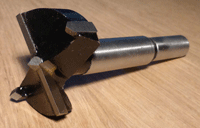Wood drill

• A - metal twist drill,
• B - wood twist drill ,
• C - concrete drill with carbide cutting edge,
• D - flat milling drill ( spade drill ) for wood,
• E - Universal
drill for metal and concrete with carbide cutting edge, • F - drill for sheet metal,
• G - universal drill for metal, wood and plastic
Types of drill shanks:
• 1, 2 - straight
shank,
• 3 - SDS-plus shank, • 4 , 5 - outer square shank ( hexagon and square),
• 6 - straight shank with three chamfers,
• 7 - ¼ inch hexagon shank
A wood drill is a drill for woodworking and is characterized by the fact that it has a fine point in the middle for centering. The two cutting edges protrude so that after the centering hole , the edge of the hole is cut first. This cuts the fibers of the wood cleanly and gives the hole a relatively smooth edge.
Wood drills are mostly made of chrome - vanadium steel and some are also carbide - tipped .
Forstner bit
Forstner bits are mainly used to produce holes with a larger diameter (available sizes: from 6 mm) as well as flat blind holes ; For example, mounting holes for concealed hinges as connecting fittings in furniture . Forstner bits each have at least one cutting edge on the lateral guide surface. In this way, good tool guidance in the material is achieved even with hand-guided drilling. Since Forstner bits are usually only made of SP steel , the tool life of the cutting edges is only very limited, depending on the material into which the drilling is carried out. Since sharpening is time-consuming due to the curved cutting edge on the lateral guide surfaces (resharpening is only possible to a limited extent without a suitable sharpening machine), artificial drills are almost exclusively used today in most carpentry shops.
Artificial drill / cylinder head drill
In contrast to Forstner bits, artificial drills have smaller lateral guide surfaces ( scoring ). Therefore, they tend to "run" when hand-guided drilling. Artificial drills are often equipped with HW ( short designation according to ISO 513 for tungsten carbide ) hard metal cutting edges and can therefore also be used for drilling panel materials, plastics and very hard woods with mineral deposits (e.g. Bankirai ). Due to the cutting arrangement, re-sharpening of the cutting z. B. easily possible with a diamond grinding wheel. Tools for automatic drilling machines with high feed rates should, however, be sharpened by machine, as hand-guided resharpening can easily change the cutting edge geometry.
Nail drill
Nail drills consist of a steel wire shaped like a helix at the end, which has either a riveted wooden toggle or a loop bent from the wire as a handle. It was mainly used to pre-drill holes for nails in order to avoid tearing narrow wooden components. Today only small diameters are in use, earlier also over 10 mm. The surface of the hole is rough because the edge of the hole tears off. However, this point is covered by the nail head. The rough wall also helps to hold the nail in place. Because it was inexpensive to manufacture, it was also used by hobbyists who did not own a drill.
A stage drill or theater drill is similar to a stronger nail drill. However, it is not used to drill holes, but to attach objects . A stage drill is a robust screw with its own handle that can be quickly screwed into the stage floor or backdrops.
Auger bits
The auger bit, also known as a rod auger bit, is a wood drill bit that is particularly used for deep holes due to its good chip conveyance. The center point has a thread which automatically pulls the drill into the wood. To create a clean drill hole, the semicircular pre-cutter first cuts through the wood fibers at the edge. Then the cutting edge, which, like the Forstner bit, runs perpendicular to the longitudinal axis of the drill, removes the chip. This is then guided upwards through the spiral groove. There are single and double thread designs, the latter being less common. The pitch of this helix is small compared to other twist drills.
Auger bits are used for deeper holes. Single-thread auger bits are used for softwood , double-thread for hardwood and end grain .
Drill saw
The drill rasp , also called stickleback or drill saw, is a special form of the wood drill . Its tip is worked out like a hand-held wooden drill. With the rasp part located behind it, arranged in a spiral shape, the drill hole can be widened after drilling through the workpiece.
Individual evidence
- ↑ Special steel: Alloyed tool steel for processing soft woods. See description in: Fraeswerkzeuge-Shop.de
- ↑ Bernd Wittchen, Elmar Josten, Thomas series: Holzfachkunde - A teaching, learning and workbook for joiners / joiners and wood mechanics , Teubner, 4th edition, 2006, p. 150.




